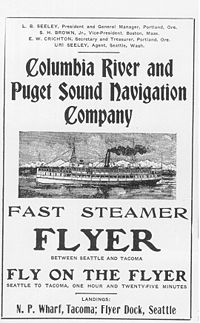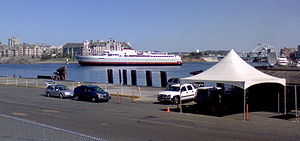Puget Sound Navigation Company
The Puget Sound Navigation Company (PSNC) was founded by Joshua Green in 1913.[1] It operated a fleet of steamboats and ferries on Puget Sound in Washington and the Georgia Strait in British Columbia. Known colloquially as the Black Ball Line, the PSNC achieved a "virtual monopoly" on cross-sound traffic in the 1930s and competed with the Canadian Pacific Railway's steamships on several routes.[2]
Before 1927, when the company was controlled by Joshua Green, the house flag consisted of a design by Mrs. Green, a red star on a white diamond on a blue background. After 1927, when Joshua Green sold his interest to the Peabody family, the Black Ball company flag was transferred over to Puget Sound Navigation Co., and the company became known as the Black Ball Line.[3]
PSNC began to struggle following World War II, as operating costs increased and its unions threatened strike action. PSNC petitioned the State Utilities Commission for permission to raise its fares, but was rebuffed. Following a long series of court battles, PSNC's unionized employees finally called a strike. The company responded not by hiring strike breakers, but by halting operations, hoping public pressure would convince the State to permit a fare increase. The State was unrelenting, however, and after having effectively forced the company out of business, PSNC's domestic operations assets were purchased by the state of Washington's Department of Transportation for the sum of $4.9 million in early 1951, creating Washington State Ferries on May 31.[2][4][5]
PSNC retained the assets used in their Canadian operations and, after the 1951 downsizing, operated a much-reduced fleet of five ships as Black Ball Ferries, Ltd. on routes between Vancouver and Nanaimo, and across Howe Sound and Jervis Inlet. In November 1961, this company sold most of its assets to BC Ferries, which had commenced operations in June 1960 as a division of the British Columbia Toll Highways and Bridges Authority, a Crown corporation of the British Columbia provincial government.[6][7]
The current descendant of the Black Ball Line is Blackball Transport, Inc., which was founded in 1936. The Black Ball Line currently operates only one route; the MV Coho operates the run between Port Angeles, WA and Victoria, BC.[7]
References
- ↑ "MetropoLIST 150: The 150 Most Influential People in Seattle/King County History". Seattle Times. http://seattletimes.nwsource.com/news/local/seattle_history/nominees/. Retrieved 2007-12-25.
- ↑ 2.0 2.1 Alan J. Stein (June 1, 2001). "The Sound and the Ferry: The Birth of Washington State Ferries". HistoryLink. http://www.historylink.org/essays/output.cfm?file_id=3325. Retrieved 2007-12-25.
- ↑ Newell, Gordon R., ed., H.W. McCurdy Marine History of the Pacific Northwest, at 87, n.2, Superior Publishing, Seattle, WA 1966 ISBN 0875642209
- ↑ "Washington State Ferries History/Creation of WSF". Washington State Department of Transportation. http://www.wsdot.wa.gov/ferries/your_wsf/index.cfm?fuseaction=our_history. Retrieved 2007-05-14.
- ↑ Alan J. Stein (January 20, 2003). "Washington State Ferries begins operations on June 1, 1951". HistoryLink. http://www.historylink.org/essays/output.cfm?file_id=5081. Retrieved 2007-12-25.
- ↑ "BC Ferries: Our History". BC Ferries. http://www.bcferries.bc.ca/corporate/history/milestones.html. Retrieved 2007-05-14.
- ↑ 7.0 7.1 "History of MV Coho and Black Ball Transport". Blackball Transport Inc.. http://cohoferry.com/main/?history. Retrieved 2007-12-25.
Coordinates: 48°24′9.12″N 123°23′59.39″W / 48.4025333°N 123.3998306°W
| ||||||||||||||||||||||||||
- Pages with broken file links
- Ferry companies based in Washington (U.S. state)
- Ferries of British Columbia
- Companies based in Washington (U.S. state)
- Companies established in 1913
- Defunct shipping companies of the United States
- Defunct shipping companies of Canada
- Defunct companies based in Washington (U.S. state)



